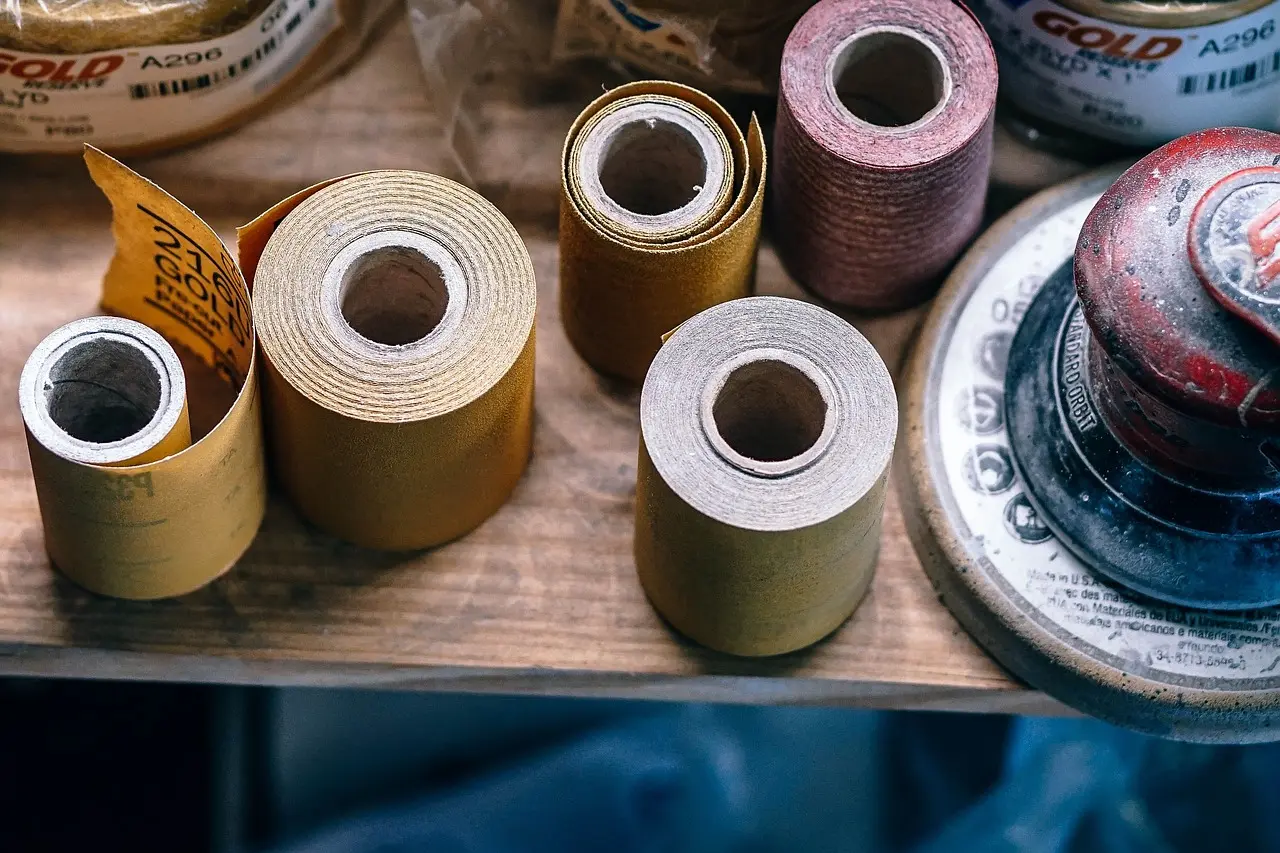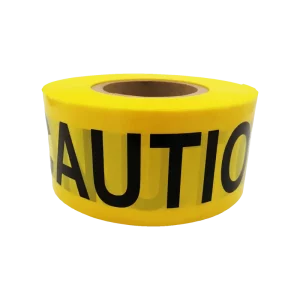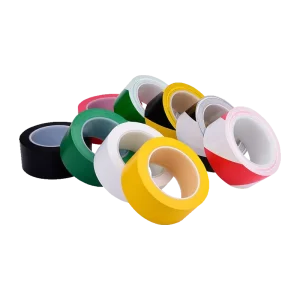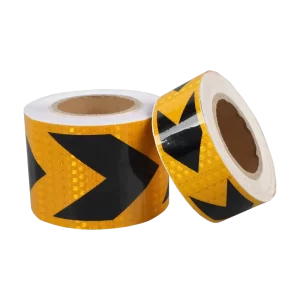1. What is Caution Tape? Caution tape, often recognized by its iconic yellow color with bold black lettering, is a versatile safety tool commonly used to designate restricted areas. It serves as a visual warning to keep people out of hazardous or off-limit zones. While yellow is the most common color, caution tape is also available in other colors like red and blue, catering to diverse industry requirements and standards.
PVC Warning Tape
Place of Origin Jiangsu, China
Brand Name warning tape
Model Number warning tape
Basic film PVC
Adhesive: rubber, mixed glue
Color: red, yellow, green, or customized
thickness 0.15mm
Click for details
2. Materials Used in Caution Tape The choice of materials in caution tape determines its durability, weather resistance, and longevity. Key materials include:
- Polyethylene (PE): Lightweight and tear-resistant, PE is suitable for short-term use, such as construction sites or temporary barricades.
- Polypropylene (PP): Known for its strength and chemical resistance, PP can withstand harsh environments, making it ideal for long-term applications.
- Vinyl (PVC): PVC offers excellent waterproofing and UV resistance, making it suitable for outdoor, long-term use.
- Paper-based caution tape: Used for temporary or indoor applications, this eco-friendly option has limited durability.
These materials can be customized based on specific requirements, such as tape thickness, color, or custom text, making caution tape a versatile option for various environments.
3. Uses and Industry Applications Caution tape finds essential applications across various industries, ensuring safety and hazard awareness in:
- Construction: Marking off construction zones to protect workers and the public from hazards.
- Transportation: Used at roadside construction sites or accident scenes to warn and restrict entry.
- Healthcare and Public Health: Hospitals, quarantine zones, and labs use caution tape for clear safety demarcations.
- Retail and Commercial Spaces: Stores often use caution tape to mark areas under maintenance, repair, or special arrangements, keeping customers informed and safe.
4. Customization for B2B Needs Customization is crucial for B2B clients who require caution tape tailored to their specific needs. Options can include branding with company logos, tailored warning messages, and custom colors or patterns. Custom solutions allow companies to maintain brand visibility while ensuring safety compliance, making caution tape a highly adaptable tool for various industries.
5. Industry Trends: Eco-Friendly Materials With a growing emphasis on sustainability, eco-friendly caution tape is gaining traction. Caution tape made from biodegradable materials is becoming available, especially suitable for temporary use and industries focused on reducing environmental impact. Eco-conscious clients can select options that deliver both performance and environmental responsibility.
6. Expanding Uses of Caution Tape Beyond safety applications, caution tape has inspired creative applications in fashion, design, and pop culture. From caution tape-inspired jewelry to clothing and tattoos, this trend showcases how caution tape has evolved from a functional safety tool to a cultural symbol, used in decorative wall installations or event decor.
7. Buying Guide for B2B Clients When choosing caution tape, B2B clients should consider factors such as:
- Material Durability: PE for short-term and PVC for long-term needs.
- 1. What is Caution Tape? Caution tape, primarily identified by its bright yellow color with bold black lettering, serves as a clear warning signal to keep people out of restricted or hazardous areas. This easily recognizable tool is essential in construction, emergency, and industrial settings, alerting workers and the public to potential dangers. While yellow caution tape is standard, other colors—such as red, green, and blue—are used for specific purposes, from signaling safety zones to marking biohazards. Caution tape may be labeled with text like “CAUTION,” “DANGER,” or “DO NOT ENTER,” providing clear, immediate communication.
- 2. Key Materials Used in Caution Tape The effectiveness of caution tape depends heavily on the materials used, which influence its durability, tear resistance, and adaptability across environments. Key materials include:
- Polyethylene (PE): Polyethylene caution tape is valued for its lightweight and tear-resistant properties. Ideal for short-term use, PE tape is easy to transport and install, commonly used on construction sites, events, and temporary barricades. Despite its lightweight nature, it provides good visibility, making it effective for quick warning setups.
- Polypropylene (PP): Known for its high tensile strength, polypropylene tape is more durable than PE and provides strong resistance to chemicals and environmental factors. PP caution tape is suited for long-term applications, particularly in industrial settings that require the tape to withstand wear, moisture, and UV exposure.
- Vinyl (PVC): Vinyl tape is recognized for its robustness, offering excellent resistance to water, UV rays, and harsh weather conditions. PVC caution tape is commonly used outdoors and in locations where long-lasting visibility and durability are essential. It is slightly heavier than PE and PP, but its durability justifies the weight for clients who need long-term solutions.
- Paper-Based Caution Tape: Primarily used in low-impact and short-term environments, such as indoor warning zones or temporary events, paper-based caution tape is an eco-friendly option that is easily disposed of. While it lacks the durability of PE or PVC, it meets the needs of clients looking for sustainable, single-use solutions.
- 3. Industry Applications and Uses of Caution Tape Caution tape’s role spans multiple industries, from construction to healthcare, contributing to workplace safety and public awareness:
- Construction Industry: Caution tape is ubiquitous in construction zones, helping mark off hazardous areas such as open trenches, equipment zones, or sections undergoing maintenance. For construction teams, caution tape is a fundamental safety tool that prevents accidents by providing high-visibility warnings to workers and pedestrians alike.
- Transportation and Traffic Control: Caution tape is crucial for temporary road closures, detours, and accident scene management. Traffic control teams rely on caution tape to clearly indicate restricted areas, keeping both motorists and pedestrians safe by delineating unsafe zones. Reflective options are also available, enhancing night-time visibility.
- Healthcare and Public Health: In healthcare environments, caution tape can mark off restricted access areas, including isolation zones, quarantine spaces, or specific laboratory sections. This usage gained prominence during health crises such as COVID-19, where delineating safe and restricted zones became essential. Custom messaging, such as “BIOHAZARD” or “QUARANTINE,” helps enhance clarity for healthcare workers and the public.
- Retail and Commercial Settings: Retail businesses and commercial venues use caution tape to mark off-limits areas for repairs, maintenance, or ongoing construction within premises. Retailers may also use custom-branded caution tape for this purpose, which can simultaneously provide warnings while promoting the brand.
- Entertainment and Event Planning: In events, caution tape is often used creatively to section off VIP areas, backstage zones, or certain displays. This application also taps into fashion and decor trends, as caution tape’s iconic look adds a visually striking element that resonates with audiences.
- 4. Customization Options for B2B Clients For B2B clients, customization options make caution tape more than just a safety tool—it becomes a branding opportunity. Companies can request custom tapes with their logos, specific warning messages, or unique color schemes that match their brand. Custom printing helps businesses enhance brand recognition and professionalism while still providing the necessary safety messaging.
- Customization also extends to materials and dimensions, allowing clients to select different tape widths, thicknesses, and even adhesion options. For example, high-tack caution tape is used in windy environments where regular tape might not hold up, while low-tack tape is preferred in indoor settings where there’s minimal risk of removal.
- 5. Industry Trends: The Rise of Eco-Friendly Caution Tape As sustainability becomes increasingly significant, eco-friendly caution tape has emerged as a popular option for companies seeking to align with environmental values. This includes caution tape made from biodegradable materials or recycled plastics, which decompose more rapidly after disposal compared to traditional materials. Biodegradable caution tape is particularly appealing in industries that emphasize environmental stewardship, such as outdoor event planning or organizations adhering to environmental compliance standards.
- This eco-conscious choice ensures that safety needs are met without compromising on environmental responsibility, making biodegradable caution tape an excellent option for single-use or temporary applications.
- 6. Expanding Cultural Applications of Caution Tape Beyond industrial and safety applications, caution tape has entered the realm of pop culture and design. Often seen in urban fashion, art installations, and themed events, caution tape has become a symbol of boundary-pushing creativity. From apparel with caution tape graphics to caution tape-inspired decor at events, this trend leverages the tape’s visual impact to convey messages about restriction, safety, and even rebellion. In the entertainment world, caution tape-themed accessories and tattoos are also popular, underlining caution tape’s broad cultural appeal.
- 7. Buying Guide for B2B Clients Selecting the right caution tape requires careful consideration of factors that impact safety, durability, and customization potential. Here’s a guide for B2B clients looking to invest in quality caution tape:
- Material and Durability: PE is suitable for temporary indoor use, while PVC offers higher durability for long-term outdoor settings. PP is ideal for environments with chemical exposure.
- Visibility and Color Selection: Bright, contrasting colors like yellow and red offer excellent visibility. Select colors that stand out in the intended environment, ensuring that the caution tape serves its purpose effectively.
- Custom Messaging and Branding: Custom printing options allow for tailored messages that meet industry-specific safety standards. Branded caution tape can add a level of professionalism and increase brand recognition at job sites.
- Sustainability Options: For companies with environmental goals, biodegradable caution tape is a responsible choice that meets safety requirements while reducing waste.
- Text and Clarity: Ensure clear, readable messages suited to the application.
- Eco-Friendly Options: For environmentally-conscious clients, biodegradable options are available.

Products
Rich variety of adhesive tape





